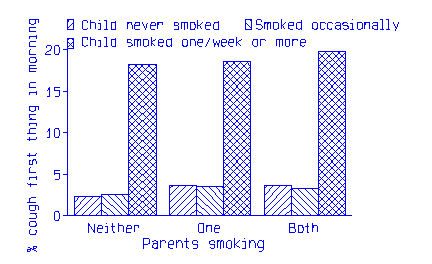Cross-sectional studies
This is a section from my text book An Introduction to Medical Statistics,
Third Edition. I hope that the topic will be useful in its own right,
as well as giving a flavour of the book. Section references are to the
book.
Cross-sectional studies
One possible approach to the sampling problem in epidemiological research
is the cross-sectional study. We take some sample or whole narrowly
defined population and observe them at one point in time. We get poor estimates
of means and proportions in any more general population, but we can look
at relationships within the sample. For example, in an epidemiological
study, Banks et al. (1978) gave questionnaires to all first year
secondary school boys in a random sample of schools in Derbyshire. Among
boys who had never smoked, 3% reported a cough first thing in the morning,
compared to 19% of boys who said that they smoked one or more cigarettes
per week. The sample was representative of boys of this age in Derbyshire
who answer questionnaires, but we want our conclusions to apply at least
to the United Kingdom, if not the developed world or the whole planet.
We argue that although the prevalence of symptoms and the strength of the
relationship may vary between populations, the existence of the relationship
is unlikely only to occur in the population studied. We cannot conclude
that smoking causes respiratory symptoms. Smoking and respiratory symptoms
may not be directly related, but may both be related to some other factor.
A factor related to both possible cause and possible effect is called confounding.
For example, children whose parents smoke may be more likely to develop
respiratory symptoms, because of passive inhalation of their parent's smoke,
and also be more influenced to try smoking themselves. We can test this
by looking separately at the relationship between the child's smoking and
symptoms for those whose parents are not smokers, and for those whose parents
are smokers. As the following figure shows, this relationship in fact persisted
and there was no reason to suppose that a third causal factor was at work:
 d
d
Most diseases are not suited to this simple cross-sectional approach,
because they are rare events. For example, lung cancer accounts for 9%
of male deaths in the UK (OPCS, DH2 No.7), and so is a very important disease.
However the proportion of people who are known to have the disease at any
given time, the prevalence, is quite low. Most deaths from lung
cancer take place after the age of 45, so we will consider a sample of
men aged 45 and over. The average remaining life span of these men, in
which they could contract lung cancer, will be about 30 years. The average
time from diagnosis to death is about a year, so of those who will contract
lung cancer only 1/30 will have been diagnosed when the sample is drawn.
Only 9% of the sample will develop lung cancer anyway, so the proportion
with the disease at any time is 1/30 times 9% = 0.3% or 3 per thousand.
We would need a very large sample indeed to get a worthwhile number of
lung cancer cases.
Cross-sectional designs are used in clinical studies also. For example,
Rodin et al. (1998) studied polycystic ovary disease (PCO) in a
random sample of Asian women from the lists of local general practices
and from a local translating service. We found that 52% of the sample had
PCO, very high compared to that found in other UK samples. However, this
would not provide a good estimate for Asian women in general, because there
may be many differences between this sample, such as their regions of origin,
and Asian women living elsewhere. We also found that PCO women had higher
fasting glucose levels than non-PCO women. As this is a comparison within
the sample, it seems plausible to conclude that among Asian women PCO tends
to be associated with raised glucose. We cannot say whether PCO raises
glucose or whether raised glucose increases the risk of PCO, because they
are measured at the same time.
References
Banks, M.H., Bewley, B.R., Bland, J.M., Dean, J.R., and Pollard, V.M. (1978)
A long term study of smoking by secondary schoolchildren. Archives of
Disease in Childhood 53, 12-19.
Rodin, D.A., Bano, G., Bland, J.M., Taylor, K., Nussey, S.S. (1998)
Polycystic ovaries and associated metabolic abnormalities in Indian subcontinent
Asian women. Clinical Endocrinology 49, 91-99.
Back to An Introduction to Medical Statistics
contents.
Back to Martin Bland's Home Page.
This page maintained by Martin Bland.
Last updated: 17 October, 2003.
Back to top.
 d
d
 d
d